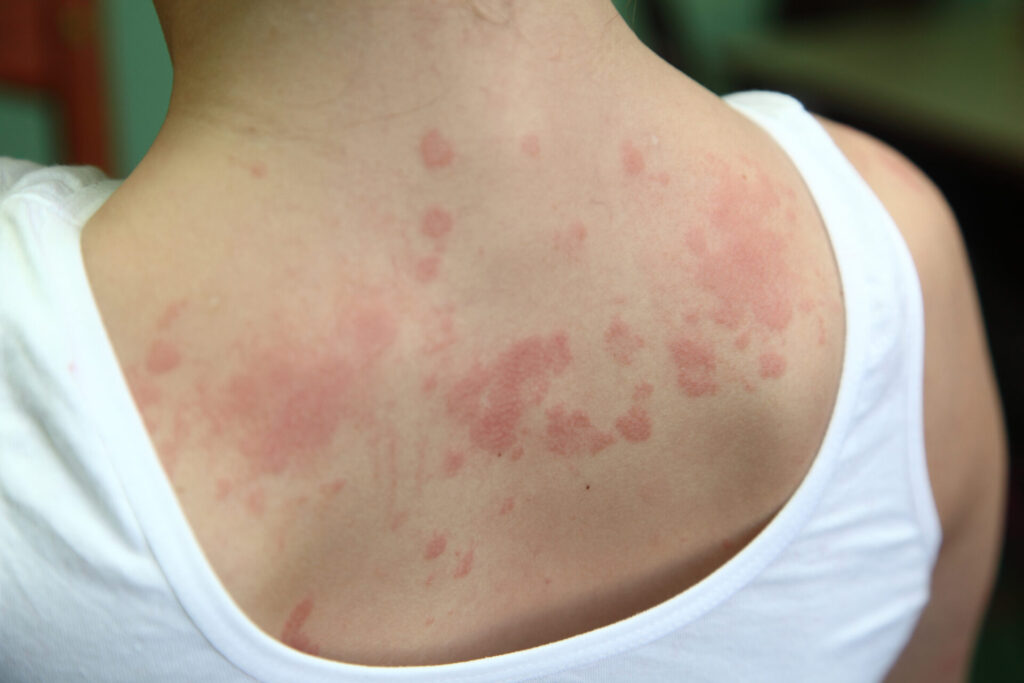Urticaria is a condition in which painful, itchy welts develop on the surface of the skin. For some urticaria patients, their stints are short-lived, with welts only appearing for a few minutes. For others, their welts reoccur often and can be long-term issues that can last for weeks, months, or even years.
Urticaria is almost always accompanied by angioedema, or swelling.
To discover more about urticaria, here are five facts to be aware of:
1. Urticaria Is the Clinical Term for Hives
If your allergist or another medical professional informs you that you have urticaria, they are telling you that you develop hives. Your condition can be either acute or chronic and can be related to several underlying issues, including:
- Autoimmune disease (autoimmune urticaria)
- Bacterial infection (bacterial urticaria)
- Physical triggers (physical urticaria)
- Viral infection (viral urticaria)
However, in most cases, hive development is caused by unknown or undiscernible causes. These hives are known as idiopathic hives.
2. Many Things Can Trigger Urticaria
As mentioned, a vast array of triggers and causes can lead to hive development.
Autoimmune Urticaria
Autoimmune diseases that often cause hives to develop can include:
- Celiac disease
- Dermatomyositis
- Diabetes
- Hashimoto disease
- Lupus
- Polymyositis
- Vasculitis
- Vitiligo
*Non-autoimmune conditions can also cause hive development, including asthma, liver disease, and lymphoma.
Bacterial Urticaria
Bacterial infections that often lead to hives include:
- Urinary tract infection (UTI)
- Strep throat
Physical Urticaria
Physical urticaria is extremely common, and triggers can include, but are not limited to:
- Food allergies
- Medication allergies
- Insect stings or bites
- Bed sores or too much physical pressure in an area
- Sun exposure
- Exercise
- Pet dander
- Pollen allergies
- Latex
- Certain plants, like poison ivy and stinging nettle
While triggers are wide-ranging, most patients develop idiopathic urticaria wherein no known triggers are present.
Viral Urticaria
Viruses that cause hives can include:
- Mononucleosis (mono)
- Influenza (the flu)
- Respiratory syncytial virus (RSV)
- The common cold
- Hepatitis
3. Urticaria Symptoms Can Appear Anywhere on the Skin

Urticaria appears as painful or itchy welts that can range in size and shape. Usually, they appear as a batch of wheals — areas that are defined by their rise and their redness or discoloration — and can bring about an intense itching or stinging sensation. With urticaria, patients also tend to experience painful swelling, or angioedema.
These batches can appear anywhere, including the:
- Abdomen
- Arms
- Back
- Buttocks
- Chest
- Face, especially the cheeks, eyes, or lips
- Legs
4. Urticaria Is Non-Threatening, But It Can Accompany Dangerous Conditions
While urticaria is typically not a life-threatening condition, if your hives are accompanied by anaphylaxis, you need to seek medical care as soon as possible.
Hive development does not mean you’ll experience anaphylaxis, nor does anaphylaxis mean you will develop hives. Anaphylactic patients just tend to experience hives during a severe allergic reaction.
5. Urticaria Treatment Is Available
If you have physical urticaria and know your triggers, you can add to your treatment by avoiding those triggers as much as possible. For some, complete avoidance is not possible, but you can help mitigate reactions by being aware of your surroundings. For instance, those whose urticaria is triggered by sun exposure should wear protective clothing and stay indoors during prime daylight hours. Those whose triggers include latex should steer clear of balloons, latex gloves, and other latex substances.
Medical treatment for urticaria can involve:
- Over-the-counter antihistamines
- Prescription antihistamines
- Corticosteroid medications
Home remedies to relax and soothe the skin can include:
- Anti-itch creams
- Cold compresses
Certain lifestyle changes can also help prevent a flareup or manage one:
- Avoid wearing tight clothing
- Choose gentle soaps over harsh ones
- Frequent bathing or soaking in oat baths may help relieve itching
- Wear sunblock and wear protective clothing
- Avoid foods you are allergic to
If you suffer from urticaria, talk to the allergy specialists at Langford Allergy.
Dr. Langford and our team will examine the rash area and consult with you about symptom duration and frequency to determine if the hives are acute or chronic. Call Langford Allergy to schedule a consultation and determine the best treatment approach for your hives or angioedema: 478-787-4728
Related articles:
